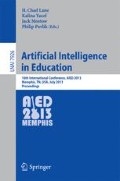Abstract
We explore the potential of bringing together the advantages of computer games and the physical world to increase engagement, collaboration and learning. We introduce EarthShake: A tangible interface and mixed-reality game consisting of an interactive multimodal earthquake table, block towers and a computer game synchronized with the physical world via depth camera sensing. EarthShake helps kids discover physics principles while experimenting with real blocks in a physical environment supported with audio and visual feedback. Students interactively make predictions, see results, grapple with disconfirming evidence and formulate explanations in forms of general principles. We report on a preliminary user study with 12 children, ages 4-8, indicating that EarthShake produces large and significant learning gains, improvement in explanation of physics concepts, and clear signs of productive collaboration and high engagement.
Access this chapter
Tax calculation will be finalised at checkout
Purchases are for personal use only
Preview
Unable to display preview. Download preview PDF.
References
Center for the Digital Future. The 2009 digital future report: Surveying the digital future-year eight. USC Annenberg School Center for the Digital Future, Los Angeles (2009)
Christel, M.G., Stevens, S.M., et al.: RumbleBlocks: Teaching Science Concepts to Young Children through a Unity Game. In: CGames, 162–166 (2012)
Fitzmaurice, G.W., Ishii, H., Buxton, W.: Bricks: laying the foundations for graspable user interfaces. In: Proceedings of the SIGCHI Conference on Human Factors in Computing Systems (CHI 1995), pp. 442–449. ACM Press (1995)
Henning, P.: Everyday Cognition and Situated Learning. In: Jonassen, D. (ed.) Handbook of Research on Educational Communications and Technology, 2nd edn. Simon & Schuster, New York (1998)
Jackson, G.T., Dempsey, K.B., McNamara, D.S.: Short and Long Term Benefits of enjoyment and Learning within a Serious Game. In: Biswas, G., Bull, S., Kay, J., Mitrovic, A. (eds.) AIED 2011. LNCS, vol. 6738, pp. 139–146. Springer, Heidelberg (2011)
Johnson, W.L., Vilhjalmsson, H., Marsella, S.: Serious Games for Language Learning: How Much Game, How Much AI? In: AIED 2005 Proceedings of the 2005 Conference on Artificial Intelligence in Education, pp. 306–313 (2005)
McQuiggan, S.W., Rowe, J.P., Lee, S., Lester, J.C.: Story-based learning: The impact of narrative on learning experiences and outcomes. In: Woolf, B.P., Aïmeur, E., Nkambou, R., Lajoie, S. (eds.) ITS 2008. LNCS, vol. 5091, pp. 530–539. Springer, Heidelberg (2008)
Quinn, H., et al.: A Framework for K-12 Science Education: Practices, Crosscutting Concepts, and Core Ideas. The National Academies Press (2012)
O’Malley, C., Stanton-Fraser, D.: Literature review in learning with tangible technologies. Nesta FutureLab Series, report 12 (2004)
Prensky, M.: Digital game-based learning. McGraw-Hill, New York (2001)
Roe, K., Mujis, D.: Children and computer games – a profile of the heavy user. European Journal of Communication 13(2), 181–200 (1998)
Schneider, B., Jermann, P., Zufferey, G., Dillenbourg, P.: Benefits of a Tangible Interface for Collaborative Learning and Interaction. IEEE Transactions on Learning Technologies 4, 222–232 (2011)
Walker, E., Burleson, W.: Using Need Validation to Design an Intelligent Tangible Learning Environment. In: Proceeding CHI 2012 Extended Abstracts on Human Factors in Computing Systems, pp. 2123–2128 (2012)
Yannier, N., Basdogan, C., Tasiran, S., Sen, O.L.: Using Haptics to Convey Cause and Effect Relations in Climate Visualization. IEEE Transactions on Haptics 1(2), 130–141 (2009)
Author information
Authors and Affiliations
Editor information
Editors and Affiliations
Rights and permissions
Copyright information
© 2013 Springer-Verlag Berlin Heidelberg
About this paper
Cite this paper
Yannier, N., Koedinger, K.R., Hudson, S.E. (2013). Tangible Collaborative Learning with a Mixed-Reality Game: EarthShake. In: Lane, H.C., Yacef, K., Mostow, J., Pavlik, P. (eds) Artificial Intelligence in Education. AIED 2013. Lecture Notes in Computer Science(), vol 7926. Springer, Berlin, Heidelberg. https://doi.org/10.1007/978-3-642-39112-5_14
Download citation
DOI: https://doi.org/10.1007/978-3-642-39112-5_14
Publisher Name: Springer, Berlin, Heidelberg
Print ISBN: 978-3-642-39111-8
Online ISBN: 978-3-642-39112-5
eBook Packages: Computer ScienceComputer Science (R0)

